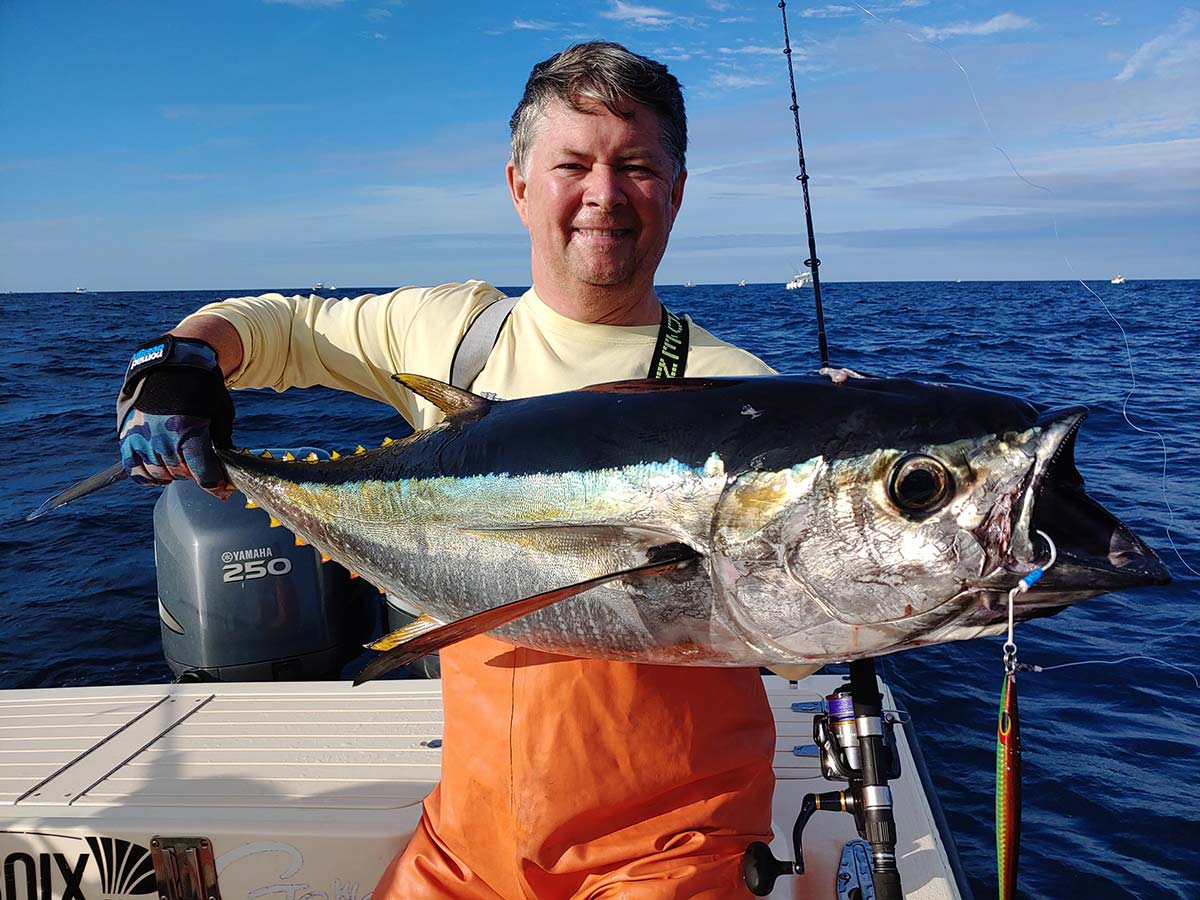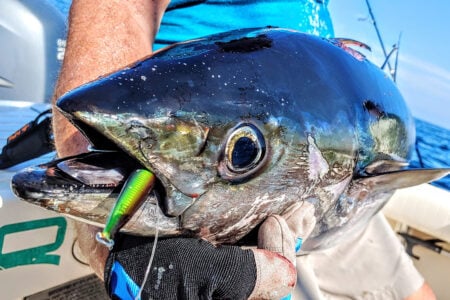
Diversify your options this month, and hopefully closer to port.
August and September is traditionally the time when canyon waters heat up for yellowfin tuna. But in recent years what has also been happening throughout the Northeast is a more inshore migration of yellowfin sometimes as close as 15 miles from the beach. The number of yellowfin showing up inshore each year has been different but there has been a consistency to it making it a viable fishery to target. And we hope this year will be no different.
Yellowfin often travel in schools with similarly sized companions, 40- to 60-pounders and 60- to 80-pounders for example, and during the early part of September we have been seeing some of the biggest yellows of the season. For my clients who are first timers to this game these tuna are truly a trill to catch especially when we jig and pop them. We can also get them on a chunk bite. Trolling at this time of year is usually not necessary and many times I just leave this heavy gear home.
Popping is our first choice as targeting yellowfin with spinning gear and poppers is an exhilarating experience and never gets old even after you have caught many. Yellowfin will explode on a popper and many times come out of nowhere to crash it. The areas we are fishing usually have plenty of bait, tuna chicks, and whale and/or dolphin feeds taking place. Slowly pulling up to these feeds and casting a popper into the melee can produce instant results. My most productive poppers are the M. Fischer, Nomad Chug Norris, and the XL Madd Mantis. Some of the most productive colors are prismatic pink or blue, white, and without a doubt the frost colored Mantis.
The jig can also be worked in areas of the feeds while anglers cast poppers. It is important to make sure however that those casting poppers are in the optimal position to make the cast, jiggers can work around them. Yellowfin tuna are usually interested in an erratic jig motion where the jig comes up quick on the lift and drops slightly on the down sweep of the rod. I have very good success jigging with 8 feet of 50- to 60-pound fluorocarbon while using 80- to 160-gram Nomad Streaker jigs, Chatterlure jigs, or CB One F-1 jigs. Full glow pink, blue sardine, and sandeel are my go to colors.
The chunk bite can take over an area especially if many boats keep pounding a particular area day after day throwing meat where fish are constantly being caught. Yellowfins seem to become wise and start to shy away from the metal. So if I want to fill the boat with a client limit then I will chunk but not completely abandon the jig or casting poppers. These can still be fished in between the three bait rods I will set out. One bait is fished on a down rod on the bottom, one bait at mid-depth on a balloon, and one bait is free drifted back into our slick.
Chunking with sardines or butterfish works but if you can bring out fresh peanuts and chunk with them you are almost guaranteed that you would get a bite going. It is even better if you net live peanuts in the morning and bring them out with you to toss into the slick. We have had many days when we hand feed the yellowfin right behind the boat.
To fish peanuts I will bury a 5/0 Gamakatsu circle hook into a peanut bunker by going through the mouth then out the gill and then into the belly. Drift the flat line baits back into the slick with no weight while making 50 pulls. It is important when you pull to maintain slack in the line so the bait looks as natural as possible when it drifts back. If no bite occurs after the 50 pulls slowly reel the bait in and repeat the process. Many times the yellowfin will hit the bait as it is drifting out pulling the line right out of your hand. So always be ready to push the lever into the strike position. I fish these baits on 8-foot, 50- to 60-pound fluorocarbon leaders but will go to 40-pound test on finicky days and to 30-pound test on real finicky days. These lighter leaders dictate the need to loosen your drag and to use a conventional rod that is very parabolic in its bend and not stiff.
In preparation for this season I bagged and froze dozens of loligo squid that we jigged when we had the tremendous inshore bluefin bite in July and the beginning of August. Three rods can be fished in the same manner as chunks. To fish the squid I will use a BKK Monster 6/0 circle hook and hook the squid at the end of the mantle in the middle of the rear fins.




